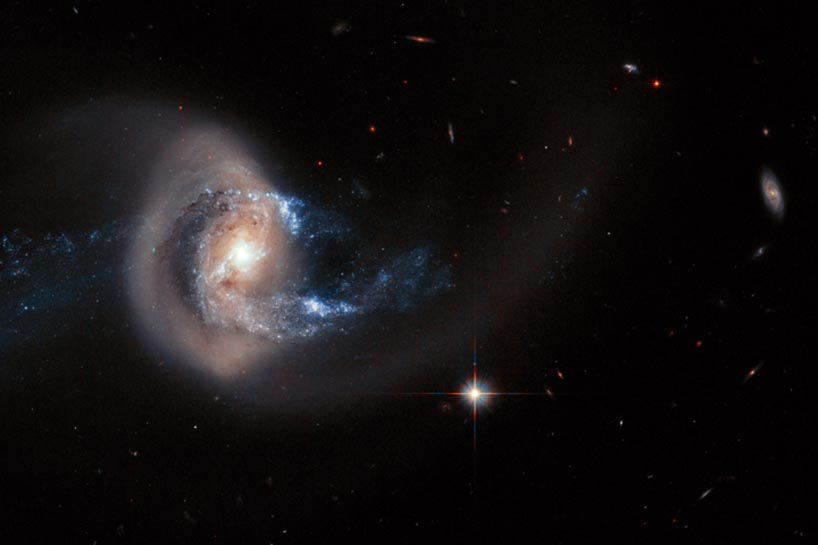
Interacting Galaxies
RA 23hr 36m 14.099s Dec +02° 09' 18.07"
Pisces
1.90 × 1.4 arcmin
12.2
100 million light years
October 16 - 24, 2011
1.1 hours
ESA, NASA, Ack: A. Gal-Yam (Weizmann Institute of Science)
January 29, 2015
ABOUT THIS IMAGE:
This NASA Hubble Space Telescope photo of NGC 7714 presents an especially striking view of the galaxy's smoke-ring-like structure. The golden loop is made of Sun-like stars that have been pulled deep into space, far from the galaxy's center. The galaxy is located approximately 100 million light-years from Earth in the direction of the constellation Pisces.
The universe is full of such galaxies that are gravitationally stretched and pulled and otherwise distorted in gravitational tug-o'-wars with bypassing galaxies.
The companion galaxy doing the "taffy pulling" in this case, NGC 7715, lies just out of the field of view in this image. A very faint bridge of stars extends to the unseen companion. The close encounter has compressed interstellar gas to trigger bursts of star formation seen in bright blue arcs extending around NGC 7714's center.
The gravitational disruption of NGC 7714 began between 100 million and 200 million years ago, at the epoch when dinosaurs ruled the Earth.
The image was taken
with the Wide Field Camera 3 and the Advanced Camera for Surveys in October
2011.
From the ESA:
The NASA/ESA Hubble Space Telescope has captured this striking view of spiral galaxy NGC 7714. This galaxy has drifted too close to another nearby galaxy and the dramatic interaction has twisted its spiral arms out of shape, dragged streams of material out into space, and triggered bright bursts of star formation.
NGC 7714 is a spiral galaxy at 100 million light-years from Earth — a relatively close neighbour in cosmic terms.
The galaxy has witnessed some violent and dramatic events in its recent past. Tell-tale signs of this brutality can be seen in NGC 7714's strangely shaped arms, and in the smoky golden haze that stretches out from the galactic center.
So what caused this disfigurement? The culprit is a smaller companion named NGC 7715, which lies just out of the frame of this image. The two galaxies [1] drifted too close together between 100 and 200 million years ago, and began to drag at and disrupt one another’s structure and shape.
As a result, a ring and two long tails of stars have emerged from NGC 7714, creating a bridge between the two galaxies. This bridge acts as a pipeline, funnelling material from NGC 7715 towards its larger companion and feeding bursts of star formation. Most of the star-forming activity is concentrated at the bright galactic center, although the whole galaxy is sparking new stars.
Astronomers characterize NGC 7714 as a typical Wolf-Rayet starburst galaxy. This is due to the stars within it; a large number of the new stars are of the Wolf-Rayet type — extremely hot and bright stars that begin their lives with dozens of times the mass of the Sun, but lose most of it very quickly via powerful winds.
This Hubble image is a composite of data capturing a broad range of wavelengths, revealing the correlation of the gas clouds and stars in the galaxy. This new picture not only reveals the intricate structure of NGC 7714, but also shows many other objects that are much further away. These background galaxies resemble faint smudges of light, some of them with spiral forms.
[1]
The interacting pair formed by NGC 7714 and NGC 7715 is named Arp 284.
From Wikipedia:
NGC 7714 is a spiral galaxy in the constellation Pisces. It was discovered
by John Herschel on September 18, 1830. NGC 7714 and NGC 7715 are interacting
galaxies. The pair are also known as Arp 284. NGC 7714 appears to be a
highly distorted spiral, possibly a barred spiral galaxy. NGC 7715 is
of uncertain type, probably an edge-on spiral or an irregular galaxy.
Supernova 1999dn was observed in NGC 7714 on September 19, 1999.